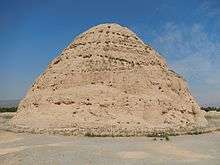Western Xia tombs

Occupying an area of some 50 km2 (19 sq mi), the Western Xia tombs at the foot of the Helan Mountains in the Ningxia Hui Autonomous Region of northwestern China includes nine imperial mausoleums and 250 tombs of imperial relatives and officials. This burial complex lies some 40 km (25 mi) westward from capital city of the Western Xia, the Xingqing fu or Xingqing, what is modern-day Yinchuan, capital of Ningxia Hui Autonomous Region.[1]
Some 17,000 m2 (180,000 sq ft) have so far been excavated, and efforts are underway to secure and preserve the remains of this poorly understood era.[2]
History
The Western Xia dynasty (also known as Tangut Empire), existed between 1038 and 1227, when it was conquered by the Mongols under Genghis Khan. The empire was founded by the Tangut ethnic group, about which little is currently known. Of current excavations, only the No.3 mausoleum has been adequately excavated and researched. This mausoleum is attributed to Western Xia's first emperor Jingzong, born Li Yuanhao, (1003-1048), has been determined as a pavilion-tower construction fusing both traditional mausoleum and temple styles with Buddhist characteristics.[2]
The Western Xia capital city and the burial complex eluded early 20th century explorers of Central Asia, including Pyotr Kozlov, Aurel Stein and Sven Hedin. During modern times, it was first reported by Wulf-Dieter Graf zu Castell, who recorded the site in an aerial photograph, published in 1938 in his book Chinaflug.[1]
Footnotes
- 1 2 Steinhardt, Nancy Shatzman (1993). "The Tangut Royal Tombs near Yinchuan". Muqarnas (PDF). Brill Publishers. 10: 369–381. doi:10.2307/1523201. JSTOR 1523201. Retrieved 2009-07-14.
- 1 2 "Xixia (Western Xia) Mausoleums: Excavation and Protection Underway". People's Daily. Retrieved 2009-07-15.
| Wikimedia Commons has media related to Western Xia tombs. |
Coordinates: 38°26′06″N 105°59′14″E / 38.43500°N 105.98722°E